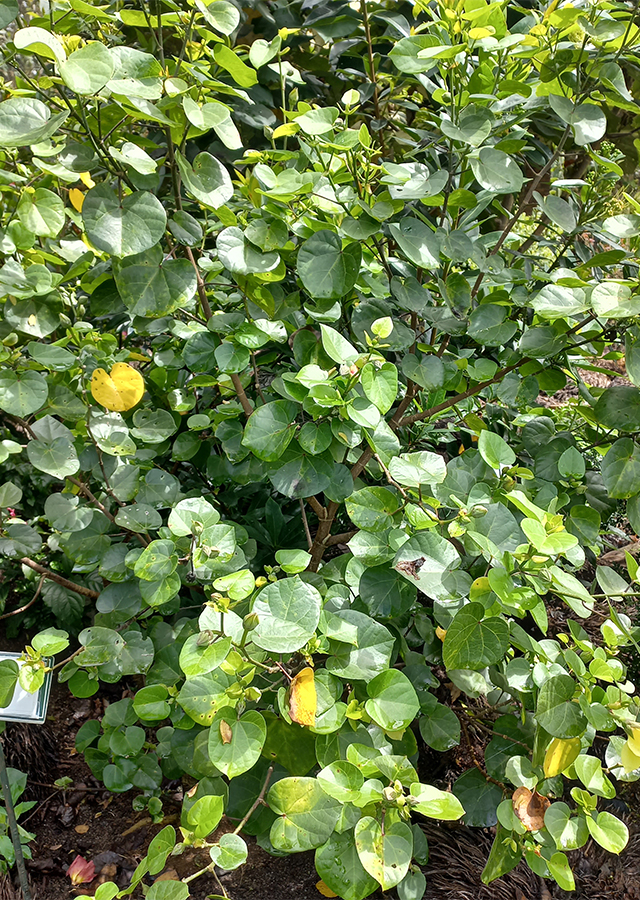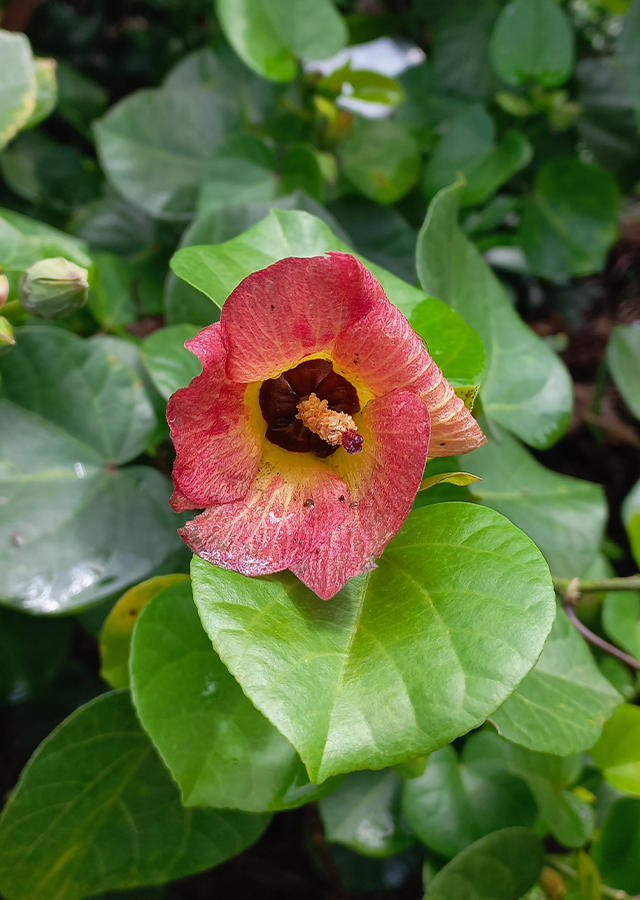Traditional Herbs from Thespesia populnea
cough
- Prepare enough fresh sea hibiscus leaves, wash them thoroughly.
- Boil the leaves until boiling.
- Strain then drink while warm.
What is Thespesia populnea Looks like??



Parts of Thespesia populnea that could be used
- Leaves", "Seeds", "Bark", "Flowers", "Fruit", "Sap
Thespesia populnea Distribution
Sea waru is a coastal plant that has a very wide native range and is widespread throughout the tropics, although it is most commonly found in coastal areas, in Central America, northern South America, the Caribbean, Africa, Asia, Northern Australia, and on the islands. Indian and Pacific Ocean islands. However, some sources suspect that the sea waru originates from tropical areas of Asia, while other sources say that it is possible that the sea waru originates from the Indian Ocean and the coast of the Pacific islands, and has been introduced and naturalized in America. Sea waru is a multipurpose plant, which has various uses as food, medicine, fiber source, wood source, wool dye, ornamental plant, shade and windbreak, and animal feed. Sea waru is also considered a sacred tree in many areas of the Pacific, where it is often planted near temples and its leaves are used in religious ceremonies. As a food ingredient, the young leaves, flowers, flower buds and unripe fruit can be consumed as vegetables, while the ripe fruit can be preserved and consumed. Sea waru bark is hard and produces strong fibers and can be used to make ropes, fishing lines, and coffee bags, while the wood is strong, hard, and resistant to insect attacks, which can be used to make light construction, musical instruments, bowls. traditional weapons, furniture, tools and vehicle bodies, and is often used for shipbuilding. Apart from that, based on its function as a medicine, this plant is often used in traditional medicine in various countries, where the bark, heartwood, leaves, flowers, fruit and seeds can be used to treat various disease complaints.Agroecology of Thespesia populnea
Sea waru is a coastal species in humid to wet areas, tropical lowlands and warm subtropics, usually found at altitudes ranging from sea level to 150 m above sea level. This plant is generally found in coastal habitats such as along beaches, bay edges, coral and sandy areas, volcanic, limestone and rocky soils, along the edges of mangrove forests, as well as in areas that are periodically flooded with water, grasslands, bushes and forests. Grows best in areas where the average annual daytime temperature is in the range of 20 - 30 °C, but can tolerate 10 - 35 °C, the average annual rainfall is in the range of 1,000 - 3,000 mm, but tolerates 800 - 5,000 mm, and the position is in full sun and growth is stunted in the shade. This species likes moist, well-drained soil with soil acidity (pH) in the range of 6.5 - 8, but tolerates 6 - 8.5. This species is also tolerant of drought, wind, occasional waterlogging, saline conditions.
Morphology of Thespesia populnea
- Taproot.
- Straight, unbranched stem up to 3 m, bark gray or light brown, smooth or slightly fissured, becomes thick and rough, and the inner bark is pink to yellowish, tough and fibrous .Twigs glabrous, green turning gray with age, and covered with very small brown scales when young.
- Leaves alternate, spirally arranged, leaf blades are round, deltoid, ovate or oval with 7 colored leaf veins. yellow, pointed leaf tips, cordate at the base, flat leaf margins, shiny dark green on the upper surface and pale below, slightly thick, rough.
- Solitary flowers in leaf axils, bisexual, bell-shaped cup, green, with 3-5 narrow green bracts. The crown is 5-lobed, wide, pale yellow, with a maroon center, and small star-shaped hairs on the outer surface The sari is numerous, united at the base of the crown. The pistil has a five-celled ovary with a slender style and five broader stigmas. Flowers open and close on the same day, with petals wilting, and turning purple or pink.
- Fruit is round but flat, 5-celled, yellowish green and becomes dark brown when ripe, hard, woody and dry, contains sap yellow, and can split into 5 parts when ripe, numbering 3-4 seeds in each part.
- Elliptical seeds, 1 cm long, brown hairy.
Cultivation of Thespesia populnea
- Propagation is carried out generatively (seeds) or vegetatively (stem or root cuttings).
- Germination from seeds takes 8 - 70 days.
- Cultivation from seeds is preferred because the wood is straight, even-grained and hard." ]
Thespesia populnea, more details :
Chemical Content of Thespesia populnea
Phosphoric acid, sesquiterpenoids (populene A-H), sesquiterpenoid quinones (mansonone D and H, thespone, and thespesone), tannins, phenols, flavonoids, terpenes, saponins, alkaloids, steroids, coumarins, anthraquinone, amino acids, glycosides, cardiac glycosides, anthocyanides , gallic acid, catechin, myricetin, protocatechuic acid, epigallocatechin gallate, rosmarinic acid, ellagic acid, routine, naringenine.
Benefits of Thespesia populnea
Treating pleurisy, cholera, colic, high fever, cough, influenza, canker sores, headaches, herpes, dysentery, hemorrhoids, diabetes, rheumatism, urinary retention, worms, treating urinary tract problems and stomach swelling, high blood pressure, infertility, loss of appetite, insect bites, kills fleas, accelerates wound healing, treats various skin diseases (external medicine), breast cancer, inhibits tumor formation. Has activity as antifungal, antibacterial, antihepatotoxic, antiamoebic, carminative, antimalarial, laxative.
Simplisia of Thespesia populnea
Another Facts for Thespesia populnea :
Synonym of Thespesia populnea
Hibiscus baccifer G.Forst., Bupariti populnea (L.) Rothm., Malvaviscus populneus (L.) Gaertn.
Habitus of Thespesia populnea
Bush. Shrubs or small, annual trees, generally the height of this plant ranges from 6-10 m, but in the wild it reaches 20 m
Habitat of Thespesia populnea
- Riverside", "Forest", "Coast", "Roadside", "Shrub Area", "Grassland", "Land
No comments:
Post a Comment